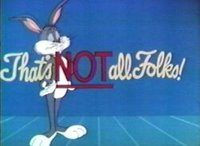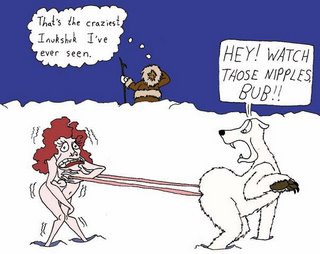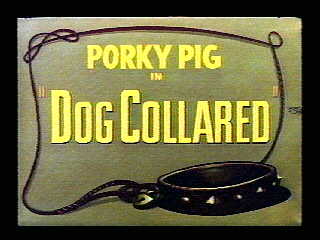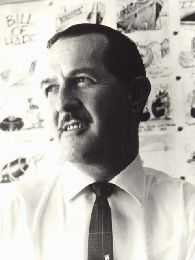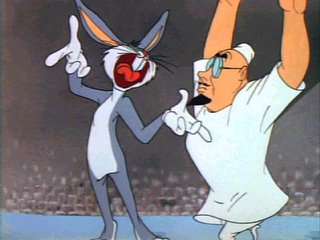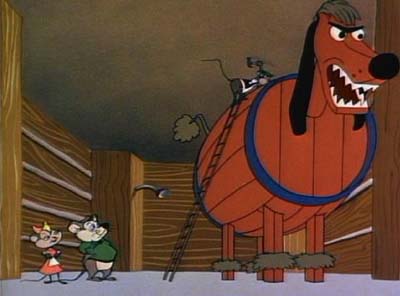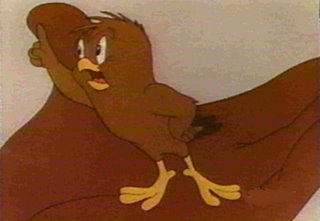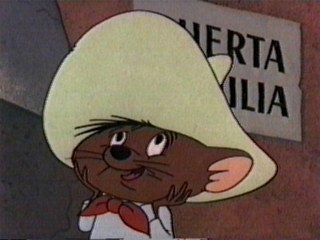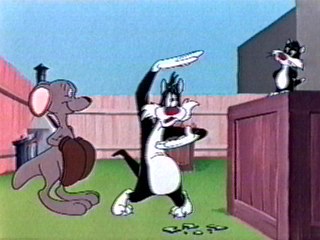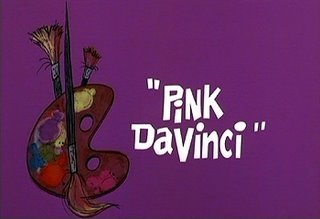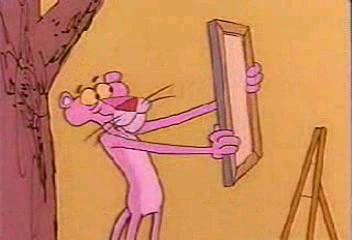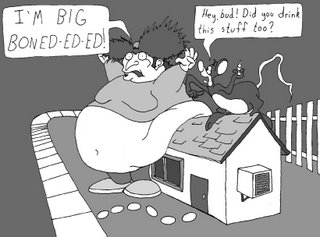
Today is the birthday of one of the greatest cartoon characters ever made, namely Bugs Bunny. Today he is 66 years young. (Of course, Warner Bros. doesn't want the Looney Tunes' ages to be known. But, you know what? These are the same people that conceived Baby Looney Tunes, Loonatics Unleashed, caused much unrepairable damage to the projects Space Jam and Looney Tunes: Back in Action (as well as other animated features on their roster) and they most recently brought us the Youtube fiasco. In light of all this: SCREW WHAT THEY WANT!!!) But enough about that, let's get back to Bugs.
I won't get into his creation story because it is too long and too involved with many many names to remember. Not only that, but Bugs essentially has two creation dates. One is April 30, 1938 which is when Ben 'Bugs' Hardaway started the basic idea in the cartoon
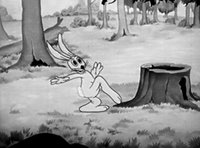
Porky's Hare Hunt and the other is July 27, 1940 when Tex Avery refined the idea of Bugs to near perfection in A Wild Hare.
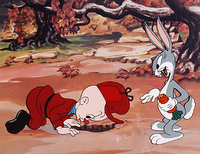
(Since I'm posting this on July 27, guess which of those dates I believe in).
The point of this blogpost is to elucidate about who Bugs is and how he manages to survive. I'll just start out by saying that Bugs' method of survival is the best way to go about it and is infinitely better than any of the comic book heroes made today or since.

For one thing, Bugs can automatically sum up his opponent no matter what the situation. Yes, I know The Terminator has this ability as well but he needs a computer program planted in his robot brain for it to work. Bugs has that ability naturally. One good example where this ability is apparent is the cartoon Hurdy Gurdy Hare (by Robert McKimson c. 1950). When Bugs is first approached by a big gorilla, he looks at him and says "Hmmmm. Obviously a barbell boy." See, right away Bugs knows his enemy and more importantly knows several schemes that could take him down. Most other super heroes have to use the trial and error method, in that they don't always know their enemy's weakness(es) right away. Much battling and pondering is required to even reach that plateau. But Bugs manages to skip that phase and thus concentrate on the imminent victory against a bald hunter, an angry redheaded outlaw, a martian, a jealous duck, or any other miscellaneous villain thrown at him.
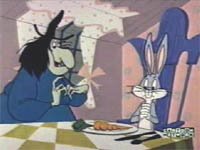
Which leads me to another aspect of Bugs: he's playful. Whether he's just out to heckle like in The Wacky Wabbit (by Bob Clampett c. 1942) or is out for vengeance like in Homeless Hare (by Chuck Jones c. 1950) Bugs always takes time to play with his opponent. And of course, the more playful Bugs is the more frustrated his opponent is. This in expotentially much more fun to watch than some bland human in tights taking things seriously all the time.
I'll even add something to this sentiment. Bugs is not only playful, but he's clever as he plays. He possesses more than enough imagination to defeat his enemies with a wide variety of tricks. In Hillbilly Hare (by Robert McKimson c. 1950), he not only carries out some clever gags, he calls a square dance as he does it. In The Unruly Hare (by Frank Tashlin c. 1945), he blocks Elmer Fudd's surveying telescope with girly pictures in Esquire magazine. In Rabbit Hood (by Chuck Jones c. 1949), Bugs actually manages to talk the Sherrif of Nottingham into a house right in the middle of one of the king's flower gardens by pretending to be a high pressure real estate salesman. Who can top such cleverness?

Yet another thing that keeps Bugs alive is his incredible adaptability skills. He can not only take on all opponents while on his own turf (the forest) he can do so on the other guy's turf as well. And when he adapts, he goes all out and definitely makes himself one with the environment. For instance, when he's involved in a Wagnerian opera with Elmer in What's Opera, Doc? (by Chuck Jones c. 1957) he plays it to the hilt, even faking his death at the end just to give it a tragic ending. When he doesn't want to get thrown off a Mississippi river boat as a stowaway in Mississippi Hare (by Chuck Jones c. 1949), he dresses like and practically BECOMES a wealthy southern gentleman in order to stay on the boat. In Southern Fried Rabbit (by Friz Freleng c. 1953) when Bugs tries to go down south for a bumper carrot crop, he has to deal with Yosemite Sam who's a Confederate soldier still fighting the Civil War. Well, Bugs pretty much re-enacts Gone With The Wind while outwitting Sam. Also look at Hare Ribbin' (by Bob Clampett c. 1944). Bugs actually becomes amphibious when he and the Russian dog take their competition under water.
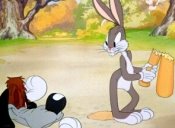
Of course, adaptability alone does not help one survive any environment. Really, anyone who is too adaptable can easily succumb to the ways of that environment and maybe even become it's slave. Bugs, on the other hand, pulls off a dazzling oxymoron each time. Even though he's fully adapted to his surroundings, his bold personality shows through the entire time. In fact, it's not long that he has the environment succumb to his ways in contrast. In Bowery Bugs (by Art Davis c. 1949) Steve Brody starts off in the cartoon as a Victorian era bar-room thug but by the cartoon's end he's hopping around like a Looney Tune repeating "What's up, Doc?! What's up, Doc?!.............". In Knight-Mare Hare (by Chuck Jones c. 1955), Bugs travels back in time with a hit on the head and meets up with a knight in a "cast-iron tuxedo". At first they trade insults in that medieval style which leads to a medieval style joust. The knight charges towards Bugs on a horse whilst Bugs is using a sword he can't even lift. But, instead of using that sword, he manages to thwart the knight in his own style by simply sticking his foot out and tripping the horse. The knight then flies off and into a castle turret where we hear him fall down the entire flight of stairs and many cartoony sound effects. But the best example of all has to be Hair Raising Hare (by Chuck Jones c. 1946). This cartoon starts off as a psychological Peter Lorre thriller. But, Bugs soon exerts his personality while playing around with the big orange hairy monster (later to be named Gossamer).

One off-shoot of adaptability is resourcefulness. If one needs to conquer one's surroundings, one must know how to use those same surroundings to his advantage. Bugs, of course, has this in spades. Take the example Wideo Wabbit (by Robert McKimson c. 1956). Here, Bugs is trying to outwit Elmer Fudd while running around in a TV station. Bugs manages to use the premises of many ofthe TV shows being shot at that station against Elmer easily. One instance of note is when Bugs disguises himself as a page and misleads Fudd into one of the studios. The door closes revaling the title of the show being shot there called "You Were There: Custar's Last Stand". Elmer Fudd then emerges from the studio with arrows and tomahawks lodged in his body. And then there's a divine masterpiece The Rabbit of Seville (by Chuck Jones c. 1950). Bugs uses every barbar tool found on the set of The Barbar of Sevile in order to humiliate Elmer. And, at the end, Bugs uses a giant cake that would later be used for another opera (The Marriage of Figaro to be exact) to dump Elmer in as a grand finale.
Well, that's quite a bit about his fighting style. Let's talk about his personality now. He's definitely NOT a one dimensional hero-type. There's somewhat of a ying-yang aspect to him. He is a good guy and generally tries to be good.

He even comes to the rescue of other characters like in Rabbits Kin (by Robert McKimson c. 1952), Foxy by Proxy (by Friz freleng c. 1952) or Bewitched Bunny (by Chuck Jones c. 1954). But there is a spark of a villainous nature in him. Sometimes this causes him to go out and look for trouble through pranks like in Buckaroo Bugs (by Bob Clampett c. 1944) , Hare Tonic (by Chuck Jones c. 1945), or Bonanza Bunny (by Robert McKimson c. 1959). But, it definitely comes in handy when Bugs must defeat any villain that makes the first move. Bugs practically beats his enemy at his own villainous game much of the time. When Bruno the acrobatic bear wants to kill Bugs during their circus performance and make it look like an accident, Bugs counters with tricks even more despicable (and clever) than Bruno in Big Top Bunny (by Robert McKimson c. 1951). Also, in Hare Splitter (by Friz Freleng c. 1948), Bugs is in competition with a goony rabbit for the affection of Daisy Lou. Bugs is certainly not above using all sorts of dirty tricks like bombs with a girl's face painted on it or a sharp cupid arrow right in the cotton tail.
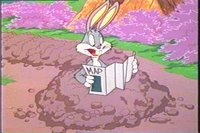
Another interesting thing to note about Bugs that really makes his personality so complex is that he is indeed an introvert. That's probably why he likes his hole in he ground. There are subtle hints of this all over many of his cartoons, but the one that stands out as the least subtle of these is Haredevil Hare (by Chuck Jones c. 1948. Here, Bugs is blasted to the moon against his will. After a crash landing. He walks out the door of the rocket, looks around and shouts in a panic, "I'M ALONE ON THE MOON!!!" But, he then says it in a more relieved tone and a smile on his face, "I'm alone on the moon." How can someone be so bold and yet so shy at the same time? Only a classic Looney Tunes director could pull that off, that's how.

I'd also like to dispell a myth about Bugs. he is NOT only capable of outwitting stupid characters. Sure, many of Bugs enemies had I.Q.'s lower than Forrest Gump's on valium. But, Bugs came upon some intelligent adversaries as well. Wile E. Coyote is probably the prime example. His I.Q. is up around 207. And yet Bugs is just as cool and confident as he would be with Elmer Fudd's "special" half cousin. So obviously, Bugs' battle techniques are just as effective against geniuses and morons alike (as well as many types inbetween). Marvin the Martian as well is quite an intellectual character. He even possesses a high-tech weapon which he aims at the Earth. Once again, Bugs is undaunted by any of this. He carries out a well executed whoppin' all with a self-assured grin on his face.
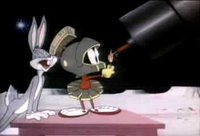
I've seen some recent backlash towards Bugs. Some say "he's an arrogant prick". Actually, I've heard that Lorne Michaels of SNL fame is an arrogant prick as well. This isn't just said by people who were fired by him in the past. Even some of his long-time friends and business colleagues regard him in this way as well. But, one of them interjected (I forget who it was) by saying, "Yes he is an arrogant prick, but with all he's accomplished over the years, he's earned that rite."
Well, the same thing can be said for Bugs as well. His superior fighting style, his complex personality, and his long list of film masterpieces earnes him the rite to be as arrogant a prick as he wants to be. (And yes, Bugs can outsmart and defeat most anybody, I don't care WHAT any hardcore Family Guy fan says. >:P )
